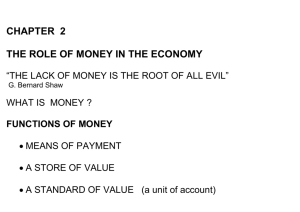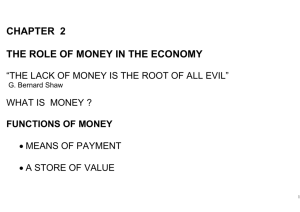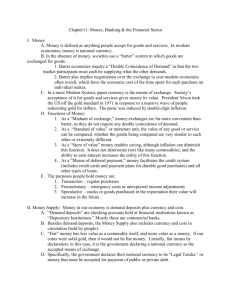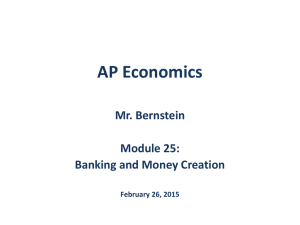Money & Banking
advertisement
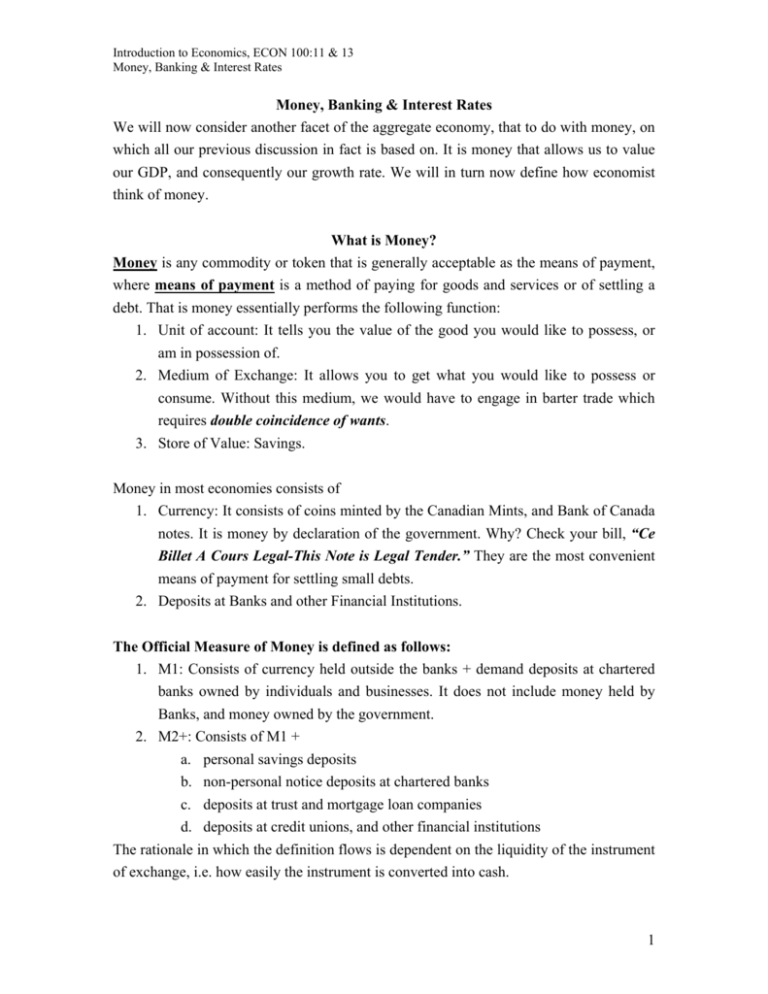
Introduction to Economics, ECON 100:11 & 13 Money, Banking & Interest Rates Money, Banking & Interest Rates We will now consider another facet of the aggregate economy, that to do with money, on which all our previous discussion in fact is based on. It is money that allows us to value our GDP, and consequently our growth rate. We will in turn now define how economist think of money. What is Money? Money is any commodity or token that is generally acceptable as the means of payment, where means of payment is a method of paying for goods and services or of settling a debt. That is money essentially performs the following function: 1. Unit of account: It tells you the value of the good you would like to possess, or am in possession of. 2. Medium of Exchange: It allows you to get what you would like to possess or consume. Without this medium, we would have to engage in barter trade which requires double coincidence of wants. 3. Store of Value: Savings. Money in most economies consists of 1. Currency: It consists of coins minted by the Canadian Mints, and Bank of Canada notes. It is money by declaration of the government. Why? Check your bill, “Ce Billet A Cours Legal-This Note is Legal Tender.” They are the most convenient means of payment for settling small debts. 2. Deposits at Banks and other Financial Institutions. The Official Measure of Money is defined as follows: 1. M1: Consists of currency held outside the banks + demand deposits at chartered banks owned by individuals and businesses. It does not include money held by Banks, and money owned by the government. 2. M2+: Consists of M1 + a. personal savings deposits b. non-personal notice deposits at chartered banks c. deposits at trust and mortgage loan companies d. deposits at credit unions, and other financial institutions The rationale in which the definition flows is dependent on the liquidity of the instrument of exchange, i.e. how easily the instrument is converted into cash. 1 Introduction to Economics, ECON 100:11 & 13 Money, Banking & Interest Rates The Banking System In Canada, it consists of 1. Depository Institutions (The functions of these various types of companies are the same): a. Chartered Banks are private firms, chartered under the Bank Act of 1992 to receive deposits and make loans. b. Credit Unions are cooperative organizations that operates under the Cooperative Credit Association Act of 1992, and receives deposits from and makes loans to its members. The parallel organizations in Quebec are called Caisses Populaires. c. Trust and Mortgage Loan Companies are privately owned depository institutions that operate under Trust and Loan Companies Act of 1992. They receive deposits, make loans, and act as trustees for pension fundes and for estates. The above financial institutions divide up their funds into Reserves and Loans. a. Reserves are to meet depositors’ withdrawals on demand. These include money in the ATM safes and bank vaults. However, this cannot be the sole purpose for the banks, since keeping your hard earn money, and giving you interest doesn’t earn them any money, unless they invest them judiciously. b. The Business of Banks and Financial Institutions is derived mainly from Loans, of which there are 4 types: i. Overnight Loans are inter-bank loans made overnight. These loans are made the morning of the following business day. The reason will be revealed to you shortly. ii. Liquid Assets: Are assets that can be easily converted in Cash should it be needed. (When would they be needed in such a hurry?) And when they are not needed, is earning a rate of return. Examples of these include Canadian government Treasury bills and commercial bills. The prices of these bills are fixed. iii. Investment Securities are longer term Canadian Government Bonds, and other bonds. These bonds can also be easily converted in cash, but are subject to variation in price/value. By virtue of the increased risk, the interest rates on these instruments are higher. iv. Loans for the purchase of houses, or other desirable durable assets. It also includes credit cards. These assets are the least liquid, and 2 Introduction to Economics, ECON 100:11 & 13 Money, Banking & Interest Rates least convertible, and consequently have the greatest rate of return. The key services of Banks are as such the following: 1. Creation of Liquidity: By borrowing and lending. 2. Minimize Cost of Borrowing: Through location, and pooling of funds. 3. Minimize the Cost of Borrowing: Hiring experts who do all the investigation of viability of repayment. 4. Pooling of Risk from default. 2. The Central Bank, which in Canada is the Bank of Canada. The rationale for its existence is not just oversight of private enterprise, possibly construed as infringement into your freedom. In fact, their existence is principally to ensure your money retains its value, and your deposit will not be used in ill-advised fashion, such as via imprudent lending. It role are as follows: a. Banker to Banks and Government, in the sense that they accept deposits from the financial institutions, and the deposits of which becomes a part of their reserves. b. Lender of Last Resort to Financial Institutions c. Sole Issuer of Bank Notes in most countries/economies with the exception of Ireland, Scotland, and Hong Kong. How Banks Create Money? It is true that economic gives us income, which we then deposit in Banks. Further, we know the sole authority who is allowed to print money in Canada is the Bank of Canada. How then can banks create money? The answer is in fact the root of the multiplier idea we have used up till now. By lending money out with your deposits, they in fact create additional deposits, because the money lent becomes someone’s income, which in turn is re-deposited. However, there are limitations to how much deposits banks can create, and consequently money. 1. The Monetary Base: The amount of money in circulation is the main impediment to excessive money/deposit creation by banks. 2. Desired Reserve: In Canada, the Bank of Canada does not require banks to set aside reserve amounts to meet exigent needs, but rather leave the decision to the bank’s own prudence. In other economies, the reserves are pegged to a percentage of total deposits held. In the US, this is 10%. In any case, any amount of money set aside for reserve purposes will reduce the ability of the banks to lend money, and consequently create deposits. 3. Desired Currency Holding: Our individual desire to hold currency implies a 3 Introduction to Economics, ECON 100:11 & 13 Money, Banking & Interest Rates denial of money/deposits to banks, and consequently reduces their ability to create deposits. We now describe the Money Creation Process: 1. Banks have excess reserves: That is given their desired level of reserves as a ratio of total deposits, they have an excess of unused deposits that could be loaned out. 2. Banks lend the excess reserves. 3. This increases deposits from lenders depositing the money to obtain in loans. 4. The quantity of money increases hence. 5. This new money is then used to make payments for purposes the loan was made. 6. The parties who receive these monies for payment of goods and services hold a portion the increase in income as holdings, reflected as currency drain. The currency drain ratio is just the ratio of currency “leaked” from the banking system (Desired Currency Holdings) to deposits held by banks. 7. The other portion is deposited. 8. The portion that is deposit into respective accounts that raise the banks’ excess reserve again. 9. The process restarts again, though it must be realized that because of the currency drain, the excess reserve is smaller now. This process goes on till the banks’ are holding just the desired reserve amount. To see this idea more clearly, let us model this idea. Let a particular bank start with a clean slate, and that they obtain a total of 1 million dollars (D) in deposit. Further, let this prudent bank’s desired reserve be 5%, or 0.05 (R) of 1 million. Let L then be the proportion of deposits the banks lend out. Based on the above description of events, and assuming there is zero currency drain, the deposit and lending process yields the following sequence of monetary transaction, D + DL + DL2 + DL3 + ...... ( ) = D 1 + L + L2 + L3 + ... D = = $20million 1− L That is with a reserve ratio of 5%, the single bank raises the money supply by 1900%! 4 Introduction to Economics, ECON 100:11 & 13 Money, Banking & Interest Rates The Money Multiplier Another way to think about this is in terms of the money multiplier, which is just the quantity of money divided by the monetary base. Based on the above calculations, this works out to be 20. A more sophisticated way of thinking about the whole process, including the currency drain, let MB be the monetary base, then MB=Desired Currency Holding + Desired Reserves That is the monetary base is the amount of money withheld from circulation within the economy. Let Quantity of Money (M) is M=Deposits + Desired Currency Holdings That is the quantity of money that could be easily liquidated and use in exchange at anytime. Let the currency drain be at a rate of d, and the desired reserve ratio be R (As above). Then Desired Currency Holding = d x Deposits Desired Reserves= R x Deposits Therefore, MB= (d + R) x Deposits M=(1+d) x Deposits Thus the multiplier is Money Multiplier = µ = (1 + d ) ≤ 0 ∂µ =− ∂R (d + R )2 1+ d M = MB d + R ∂µ − (1 − R ) = ≤0 ∂d (d + R )2 The first equality above gives the formula for the money multiplier in terms of the currency drain ratio, and the reserve ratio. The first inequality says that the greater the reserve ratio, the smaller the money multiplier, while the second inequality says that the greater the ratio of currency drain, the smaller the multiplier. Both of the latter comments are very intuitive, in the sense that the greater the withdrawal from the banking system, the lower the ability of the banking system to create money, and consequently the lower the money multiplier. To see if this formula is correct in relation to our first example, note that we had assumed that d was 0. At R of 0.05, and d of 0, you can easily show yourself that the multiplier is in fact 20 as we had found. 5 Introduction to Economics, ECON 100:11 & 13 Money, Banking & Interest Rates The Demand for Money So what influences our money holding? 1. The price level: The quantity of money measured in dollars is nominal money. The quantity of nominal money demanded is proportional to the price level. The greater the price level, the greater would the nominal holding of money to maintain purchasing power. Real money accounts for changes in prices of the goods we consume, and is just nominal money divided by prices of a base year for proper comparison of purchasing power. That is the adjustment is similar to the relationship between nominal and real GDP. 2. Interest Rate is the implicit value of money since the longer we hold onto to money in our wallets, we are foregoing interest income we could be earning. That is interest rates reflect the opportunity cost of holding money instead of depositing it in a financial institution. 3. Real GDP: The wealthier the economy is, the higher likelihood of yourself being wealthier, and the increased need for increased holding of money to make your purchases. 4. Financial innovation has gradually decreased our need to holding money in our wallets, through such means as Automated Teller Machines, Credit Cards, Electronic Transfers, etc. Price level affects how much we would like to keep in our wallets. The demand for money tells us the relationship between the quantity of real money and interest rate when all other things influencing the amount of money that people wish to hold remain constant. Based on what you have learned in Microeconomics, when the price of a good rises, the less we demand of a good, and vice versa. Similarly here, as the opportunity cost of holding money, in the form of interest rates, falls money becomes cheaper to hold, and consequently we want more of it, and vice versa. That is, it is a downward sloping curve, as depicted below. 6 Introduction to Economics, ECON 100:11 & 13 Money, Banking & Interest Rates Interest Rate, i/r Money Demand,MD Real Money,(M/p) Based on what we have discussed prior on the determinants of money holding, we know that changes in price will not affect our holding of money, consequently our demand of money. However, changes in Real GDP, and Financial innovation will change money demand. Specifically, an increase in real GDP will increase our demand for money, and consequently shift money demand to the right, and vice versa. Similarly, financial innovation that makes the holding of money irrelevant, will decrease our holding of money, and consequently reduce money demand and shift the curve to the left. Interest Rate Determination Interest rate is the percentage yield on a financial security such as a bond or a stock, or the payment to your fixed term deposits. A bond is a promise to make a sequence of future payments. There are various sequences, but we will focus on the simplest one to isolate the relationship between interest rates, and price of bonds. The reasoning can easily be extended to other instruments. Consider the perpetuity, a bond that promises to pay the holder of the bond a fixed amount of money each year forever. That is this instrument will never be redeemed, i.e. the issuer of the bond will never by the bond back, and will make that obligation in perpetuity. The interest rate on a perpetuity is then payment ir = × 100 price of perpetuity It is clear then that the greater the price, the lower is the interest rate. 7 Introduction to Economics, ECON 100:11 & 13 Money, Banking & Interest Rates Money Market Equilibrium It is the supply or and demand for money that determines the interest rate. Simply, based on your microeconomic analysis, the equilibrium in the money market is the point where both the demand and supply of money are equal. Beyond which, differing actions by the constituents of the economy will bring the money market into equilibrium (What are they when we have an excess demand, and excess supply of money?). Since the central bank, or in the case of Canada, the Bank the Canada has full jurisdiction over the supply of money, it can determine the terms on which currency and reserves for the banks are supplied. There lies the crux of monetary policy. The Bank of Canada, or any central bank for that matter can do one of the following, 1. Target the Quantity of Money When we say the central bank sets the quantity of money, it means that it has a fixed supply of money it wishes to maintain in the economy, or market. This then means that the money supply line is a vertical line, at a particular level of real money supply. When this occurs, equilibrium occurs where demand and supply of money meets, and interest rate is consequently decided. What is the mechanism by which this occurs? Consider the following, if there is an excess demand to the money supply preset by the Bank of Canada. The meet their demand for money, the constituents in the economy who demands money would liquidate their assets such as bonds. By the action of selling bonds, using demand and supply analysis, you can show yourself that the fall in demand for bonds would lead to a left ward shift in supply, and consequently a fall in the price of bonds. Consequently, using the simple example we have above on a perpetuity, this fall in price would raise interest rates, or the yield on the bonds. (The diagram for this analysis will be provided in class.) Think of it another way, suppose we all decide we want more money, when we decide to reduce our bank deposits unanimously, that is a fall in supply of deposits for the banks, who then in turn needs to offer to pay you more in interest rate to attract you into depositing your monies with them again. 2. Target the Interest Rate Another manner in which the Central Bank can control equilibrium is through focusing on a particular level of interest rate. That interest rate would determine the amount of money supply the central bank has to maintain in the market. 8




